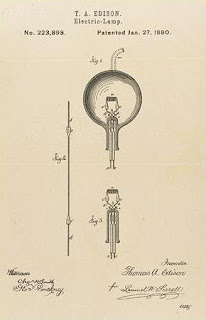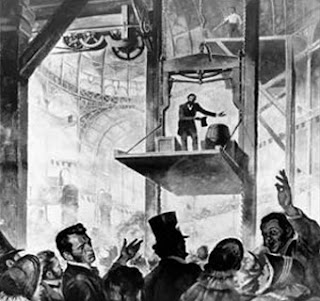Ponder Questions and Answers about Inventions
" I haven't failed, I've just found 10,000 ways that won't work" - Thomas Edison
 1. The dissemination of an invention is not always premised on benefiting the society. Different groups of people wage figurative and literal battles to make an invention a social necessity or to stop one from being such. Why do you think is so?
1. The dissemination of an invention is not always premised on benefiting the society. Different groups of people wage figurative and literal battles to make an invention a social necessity or to stop one from being such. Why do you think is so?
Since the technology world is very cutthroat place. Competitions with each inventors and different companies occur frequently. Sometimes inventors are blaming and censuring other inventions by finding some mechanical defects and mistakes of the invention. Not all of the inventions are really benefitting the society, most of the inventions have both advantage and disadvantage. But some of the inventors who had very clever idea and invented a groundbreaking and amazing inventions and contrivance like light bulb(1879) of Thomas Edison and Antonio Meucci who invented telephone(1854). So whenever new inventions launches inventors should appeal to people that it is necessary to our society. Sometimes they use SNS or Websites as a tool to contact people or make their inventions as a new fad of the society so that people would approach to their inventions with interest.
"All safe, Gentlemen, All safe." - Otis
An elevator is a mechanical device used to move a person or cargo vertically using power. Lifts are often considered synonymous with elevators, but in the UK the term lift is used. Today, elevators have become essential in high-rise buildings. On a hot summer day, a high-rise building that does not have an elevator can be imagined. Human beings have long dreamed of elevators, but modern elevators have been popularized by Elisha Graves Otis (1811-1861), a 19th century American engineer. In fact, the term elevator also comes from the brand name of elevators developed by Otis.
A lot of people got benefit from the great groundbreaking invention, elevator. On the other hand, a method of accelerating the elevator by hanging the cage on the rope was also studied. However, the people in the elevators were very dangerous. Otis was the one who solved this problem. He attaches a safety device to the elevator at the top of the cage rope. The principle of the safety device invented by Otis was the gear wheel and brake device according to the spring device wagon, which only worked when the pulling force of the rope ceased.
The lift with Otis' first safeguard by steam was first installed in 1857 at the Haworth Company's New York branch. And in 1904 Otis developed a tow elevator without cog wheels. This elevator is fast, simple in structure, and has low-cost features that allow people to carry it higher. In 1857, three years after the New York Inventions Fair, Otis' elevators began to spread. Otis' elevator was installed at the Howe Wight department store, a five-story building on Broadway. It was the world's first passenger lift. It was driven by a steam engine located in the center of the building, capable of lifting a load of 453 kilograms at a speed of 12.2 meters per minute.
Otis was patented on January 15, 1861, designed for a safety elevator. But a few months later he left the world at the age of 49. His business was handed down to his two sons, and Otis became a global elevator company. Otis' s sons developed the first commercial hydraulic elevator in 1878, which was more secure and less expensive to install than conventional elevators using wire ropes.
In 1880, Werner von Siemens of Germany developed an elevator using an electric motor instead of a steam engine. In 1889, Otis succeeded in commercializing the first electric elevator. In 1882, a hydraulic braking system began to appear instead of a hydraulic braking system, and Otis introduced the elevator in 1903 with significantly improved speed and braking functions. With the advent of hydraulic elevators, the speed of the elevators has improved to 35 meters per minute. Since then, efforts to increase the speed and safety of the elevators have continued.
Authorities in the companies who are selling and exporting the elevators and the people are utilising the elevator for their building and constructions got great advantage.
 On the evening of April 30, 1931, people's gaze was concentrated on 34th Street in Manhattan, New York. A 102-story building with a height of 381 meters was exposed, and 6,400 windows were lit at once. The completion ceremony of the Empire State Building was held. The fact that the Empire State Building was actually created was the 67 elevators produced by Otis.
On the evening of April 30, 1931, people's gaze was concentrated on 34th Street in Manhattan, New York. A 102-story building with a height of 381 meters was exposed, and 6,400 windows were lit at once. The completion ceremony of the Empire State Building was held. The fact that the Empire State Building was actually created was the 67 elevators produced by Otis.
The Empire State Building was the tallest building in the world until 1971 when the 417-meter World Trade Center was erected. The World Trade Center, which collapsed in 2001, has a total of 255 lifts.
Before and after building the Empire State Building, a so-called "skyscraper fever" broke out in Manhattan, New York. If you solve the skyscraper literally, it becomes a building that touches the sky. At the time of the skyscraper, an elevator boy or elevator hanger was placed to guide passengers on the elevator. Elevators In 1948, the automatic controls and layer selection buttons were introduced and began to hide.
3. Think of a specific technology that has not been invented yet, but you feel might benefit people.
'Terrafugia' is a well-known company that wants to build a car that can fly. However, their dreams will come true in the not-too-distant future. If it comes out, it says that the car named 'TF-X' is the first model and now lies in 'important historical events' during the development stage."The TF-X is a car with four seats and a hybrid electric powertrain, vertical takeoff," the company explained. The R & D drones currently under test are said to be capable of flying at a speed of 160 km / h over 400 ft.
"Terafugu engineers are preparing a detailed test plan for the TF-X, which will be used to drive and test the car," the company said.
The Top Gear in the UK has finished with a statement that the reality of a car that is flying in the sky is getting closer.
Known for the TF-X, it is powered by a plug-in hybrid powertrain. The electric motor and the gasoline engine deliver 300 horsepower, with a maximum speed of 320 km / h and a maximum travel distance of 804 km. "At that speed, it's the speed you can get from London to Geneva in three hours," Top Gear says. TF-X is said to be commercially available as early as eight years ago.
4. Winston considers the acceptance of new innovations "more difficult to discern." Why do you think is this so?
If the innovations are introduced or released little by little people or the customers should have to follow the technological trends or the fads by buying the things that re lately released device that has new technologies. If it is the case, the people who are in the authority or CEOs would get a good profits. Their business would success by releasing new technologies by introducing it little bit earlier than their rival companies with lower price.













